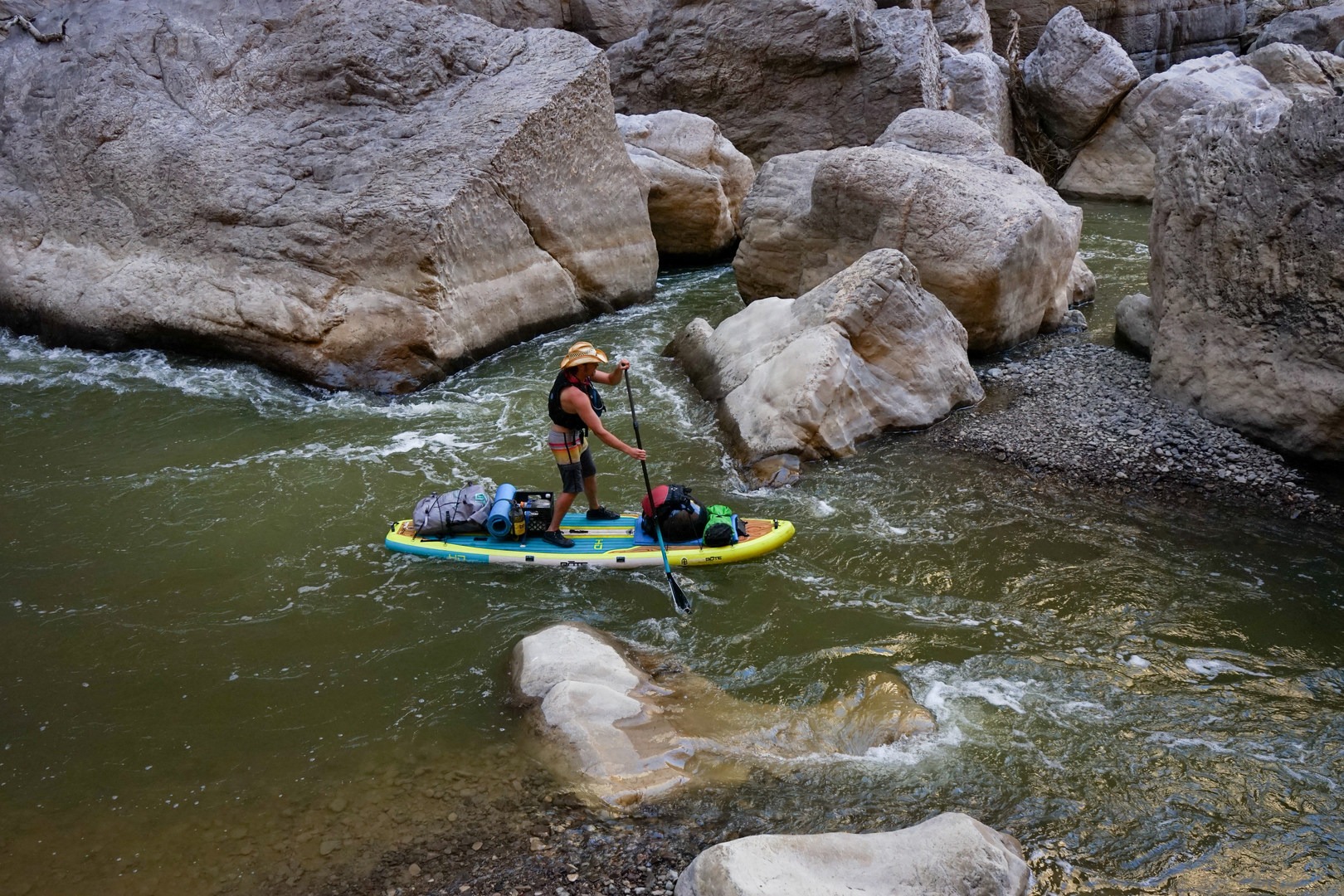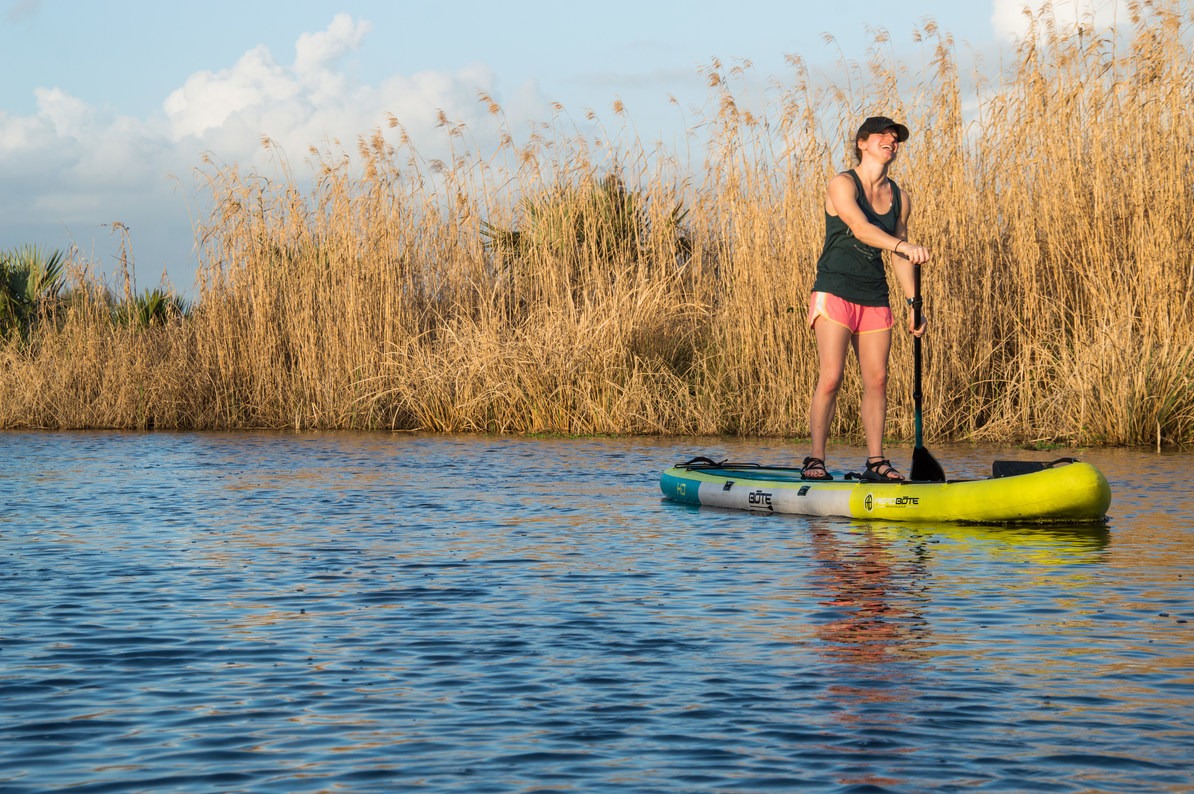Bote HD Aero specs
- Length: 11 feet 6 inches
- Width: 34 inches
- Thickness: 6 inches
- Weight: 30 lbs
- Max Capacity: 315 lbs
Where to get it
$1,299 • Boteboard.com | REI | Moosejaw
The bottom line: The Bote HD Aero inflatable SUP is billed as the "one board for everything," so we duly tested that claim by pitting it against two very different environments: backwoods bayous of Louisiana and remote desert whitewater of the Rio Grande in Texas. It lives up to its claim. The board proved versatile in any type of current, durable when impacting rocks, and resilient to frequent packing and unpacking on the road. The design is stocky and strong rather than sleek, which means that some speed is sacrificed for excellent stability, agility, and weight capacity. The HD is the go-anywhere tool for a beginner or intermediate paddler looking to step it up in endurance and currents, and it is a workhorse for the seriously adventurous paddleboard fisherman.
Enjoying the Bote HD Aero SUP in Louisiana. Photo by Jesse Weber
A two-week road trip in Louisiana was the board's first test, and the itinerary was a great way to evaluate portability between destinations, light loads on flatwater, and moderate mileage on slow-moving current. And the board handled almost everything swimmingly. Its fairly high width to length ratio (34 inches at the widest and 11 feet 6 inches long) makes it quite stable. The somewhat squat shape combined with the nose rocker and buoyancy of a 6-inch thickness makes it very stable even when it is floating high and turning. The board easily maneuvered through flooded swamp forests during Louisiana's rainy season.
These design choices sacrifice speed and tracking, but that's no surprise given the board's somewhat fat design. If you'll be paddling a considerable distance or against any current, you'll definitely want to attach the removable fin and have your paddle strokes practiced; otherwise, it's very difficult to maintain a straight line. The HD takes more work to move forward than a touring board, which would be more streamlined but less agile.
The Paddle Sheath that on the board's deck proved to be an excellent bonus feature for going hands free. It's a detachable slot on the nose of the board that is designed for inserting the paddle blade and stowing within arm's reach. This was great on the bayous, where fishing and photography were priorities along with paddling. Features sold separately include tackle racks, bucket racks, and coolers to really step up the functionality for serious fishing and touring.
The board is heavy (30 lbs), and drop-stitch construction ensures it is stiff when fully inflated. It feels very similar to a rigid board, which is a major plus in choppy water or when carrying a heavy load. Reaching proper pressure does take a fair amount of work, but the included bicycle-style pump can get it there in about 10 minutes. Deflating is easy, and it rolls simply to a size that can fit in the included carrying bag, which doubles as a large dry bag backpack.
For casual cruises through the swamp or on a lake, fishing, and watching for wildlife, the HD is perfect. Where it suffers is paddling long distances, especially against a current or into a headwind, but an experienced paddler can still manage.
Given the design priorities of stability and maneuverability over speed, we thought the HD might handle well in whitewater and carry a lot of weight. We threw in both factors at once on the Santa Elena section of the Rio Grande, an overnight float through open desert and a vertical gorge on the border of Texas and Mexico.
Anticipating low water in the desert and tight turns in the canyon, we slid out the center fin, leaving only the two small fixed fins on the board. Next we used the included bungees and D-rings plus some cam straps to load the HD with more than enough gear to survive a night on the river. Supplies plus a human weighed an estimated 215 pounds, still well under the 315-pound recommended max capacity.
The extra load actually made the board feel more stable, but much harder to maneuver, especially in a swift current. In the relatively mellow rapids of the Rio Grande (Class I-II), however, this could be overcome with skillful paddling. Only two or three times did the paddler run into a rock wall and pitch off into the water, an acceptable amount of error in our opinion; the board itself never flipped, importantly, which allowed for speedy self rescue.
The most obvious disadvantage on whitewater came in the form of the stiff, fixed fins beneath the tail of the board. These fins would catch on rocks in shallow rapids, causing more than one lurching forward fall. For this type of treatment, flexible river fins would be preferable. In defense of the design, however, these fixed fins held up quite well, looking hardly worse for wear even after frequent battering on the rocks. Admittedly, the technical rapids of the Rio Grande are probably outside the scope of normal use, especially with an overnight load, but for a board that claims versatility as its principle intent, we felt this was a fair test.
One sign of wear we've noticed after many times rolling and unrolling the board and getting on the water, aside from typical scuff marks and superficial scratches, is the BVA foam deck pad beginning to delaminate in a few small spots on the edge. This is inconsequential and easily fixed with some super glue, but it remains to be seen how this holds up in the future.
Overall, the board passed with flying colors on stability, maneuverability, and weight capacity. Rigidity is key to performance, and the work it takes to fully inflate subtracts a point or two in the portability category, but this is offset by the ease with which the board is rolled and packed in the included dry bag backpack. The board won't win any awards for speed, but this is to be expected from an all-purpose board. If you want an inflatable board that really can handle just about anything you throw at it and load onto it, the Bote HD Aero is for you.






Comments
Sign In and share them.